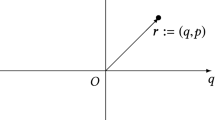Abstract
We consider the quantization of identical particles. We suggest an a priori argument for identification of the classical configuration space. In two spatial dimensions, for two particles, this yields the (by now) familiar cone with deficit angle of π, with the vertex removed. We find two fundamental parameters which characterize the quantum theory. The first, θ, is associated to the multiple connectedness of the cone, while the other, α, is associated to the question of unitarity. θ describes the statistics of the particles and gives rise to anyons. α specifies the boundary conditions to be imposed on the wave functions at the vertex of the cone. We show by explicit example that α can be regarded as a vestige of short distance interactions between the particles, leaving θ as the truly, obligatory, appurtenance of the quantum mechanics of identical particles is two spatial dimensions. We also analyze the symmetries of the quantum Hamiltonian and find a dynamical SO(2, 1) symmetry, acting on the space of Hilbert spaces with different boundary conditions.
Similar content being viewed by others
References
J.M. Leinaas and J. Myrheim, Nuovo Cim.B37 (1977), 1.
M. Bourdeau and R. Sorkin, Phys. Rev. D45 (1992), 687.
M.G.G. Laidlaw and Morette C. DeWitt, Phys. Rev. D3 (1971), 1375.
Y.-S. Wu, Phys. Rev. Lett.52 (1984), 2103.
L.S. Schulman,Techniques and Applications of Path Integration, Wiley, New York, 1981.
F. Wilczek, Phys. Rev. Lett.48 (1982), 1144; Phys. Rev. Lett.49 (1982), 957.
S. Artz, T.H. Hansson, A. Karlhede, and T. Staab, Phys. Lett.B267 (1991), 389; J. Grundberg, T.H. Hansson, and J.M. Leinaas, Mod. Phys. Lett.B5 (1991), 539; C.R. Hagen, Phys. Rev. Lett.64 (1991), 503; B. Kay and U. Studer, Comm. Math. Phys.139 (1991), 103; S. Deser and R. Jackiw, Comm. Math. Phys.118 (1988), 495; Gerbert P. De Sousa, R. Jackiw, Comm. Math. Phys.124 (1989), 229.
V. Rubakov, JETP Lett.33 (1982), 644; C. Callan, Phys. Rev. D25 (1983), 214.
R. Dutt, A. Khare, and U. Sukhatme, Am. Jour. Phys.56 (1988), 163; A. Gangopadhay, P.K. Panigrahi and U. Sukhatme,UdeM-LPS-TH-153.
R. Jackiw, δ-function potentials in 2-dimensional and 3-dimensional quantum mechanics, Preprint MIT-CTP-1937, 1991 (to be published, Bég memorial volume).
M. Reed and B. Simon,Methods of Modern Mathematical Physics. Vol. 1, 2, Academic Press, New York, 1972; E. D'Hoker and L. Vinet, vol. 97, 1985.
Additional information
This paper is dedicated to the memory of M. C. Polivanov.
Laboratoire de Physique Nucléaire, Université de Montréal. Published in Teoreticheskaya i Matematicheskaya Fizika, Vol. 98, No. 1, pp. 80–89, January, 1994.
Rights and permissions
About this article
Cite this article
MacKenzie, R., Panigrahi, P.K., Paranjape, M.B. et al. On the quantization of identical particles. Theor Math Phys 98, 55–60 (1994). https://doi.org/10.1007/BF01015124
Received:
Issue Date:
DOI: https://doi.org/10.1007/BF01015124




